Increasing the Lifespan of Ozone Improves Water Treatment
Published on by Water Network Research, Official research team of The Water Network in Technology
Kenneth “KC” Carroll, an associate professor in New Mexico State University’s College of Agricultural, Consumer and Environmental Sciences, and his collaborators have discovered an increase in the lifespan of ozone, giving more time for it to treat water both in groundwater and in wastewater treatment systems.
By Melissa R. Rutter

Naima Khan, who received her Master of Science and Ph.D. in Water Science and Management at NMSU with Kenneth "KC" Carroll, can be seen inspecting experimental water samples in the lab where she does chemical analysis, including mass spectrometry to determine if ozone has reacted with organic contaminants in water. (Image source: newscenter.nmsu.edu)
Some water contaminants are more difficult to treat, remove or destroy and they require more reactive methods when traditional methods are inhibited, but these more reactive methods can be too rapid to transport significant distances in groundwater.
Some recalcitrant contaminants found in groundwater cannot be destroyed with traditional methods, so strong oxidants are needed.
“The problem with this type of approach is that strong oxidants are highly reactive so it’s difficult to transport them into the environment to treat the contaminants that are there,” said Carroll, a faculty member in the college’s Department of Plant and Environmental Sciences. “So, we came up with a method of incasing ozone inside another molecule.”
A novel molecular container, cyclodextrin, was used by NMSU, University of Rhode Island and Enchem Engineering, to stabilize ozone. This molecular container shields ozone from reacting with chemicals in water, which is why it decays so quickly.
“Cyclodextrin was created by pharmaceutical companies to deliver drugs into human bodies so, we’re extending it by applying it to deliver treatment to contaminated groundwater now,” Carroll said.
The research is transforming the ways people are able to remove contaminants in both groundwater and in waste-water treatment plants as we extend applicability of ozone as a treatment method for contaminated water.
“We try to see if we can treat contaminants within subsurface groundwater systems. We’re trying to take the treatment to the contamination as opposed to trying to extract contaminants for treatment in an above-ground plant. We believe it’s more effective to treat contaminants in place, because you can focus on the treatment instead of extracting them,” Carroll said.
This new water treatment method will decrease human exposure to carcinogens, results can be used worldwide, and results enable cleanup of contaminated groundwater.
“We were able to increase the lifespan of ozone. Ozone reacts very rapidly with water so typically in most groundwater systems ozone will have a half-life of up to one hour, which means every hour the concentration drops by one-half,” Carroll said. “We were able to extend the ozone lifetime such that the half-life increased up to 40-fold. This is a really significant extension of the reactive lifetime of ozone, and this extends our ability to treat water both in groundwater and also in waste-water systems.”
Carroll was unsure if the highly reactive ozone would react with the cyclodextrin. He found that part of the ozone does react and part of it does not, which allows for ozone to be stabilized within the cyclodextrin molecule and transported into groundwater.
“We were hoping that we would extend the lifespan of ozone even longer, but we didn’t realize that ozone was so reactive and so short-lived. So, it’s kind of a significant challenge, because it goes away quickly. But being able to extend it is really significant,” Carroll said.
Media
Taxonomy
- Ozonation
- Decontamination
- Produced Water Treatment
- Drinking Water Treatment
- Water Treatment & Control
- Decontamination
- Ozone
- Water Treatment Solutions
- Contaminant Removal
- Chemistry
- Groundwater
- Groundwater Pollution
- Agrochemicals
- Agrochemicals
- Environment
- water treatment